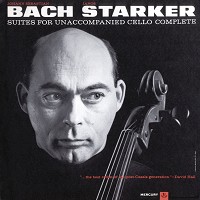Rare originals of this recording have been going on Ebay for upwards of $1,500. The sound quality and performance are absolutely to-die-for.
Today, it is difficult to understand that despite the tremendous Bach renaissance that took place in the 19th century, many compositions by the Cantor of St. Thomas’ Church in Leipzig had been underrated. The Cello Suites, for example, have been regarded for almost 300 years as purely a set of tricky etudes that every virtuoso in the making simply must tackle. Janos Starker’s recording of the Suites from 1965 makes a lasting impression on the listener, and even record producers who are well used to recorded excellence have been highly impressed. Starker’s full-bodied sound and technical brilliance are complemented by his finely chiseled interpretation that lends immense expression to Bach’s thrilling harmony and verve to the strict rhythmic construction of the movements.
Just listen to his organ-like double-stopped passages, the eloquent dialogues, and the pure excitement he conjures up with his bow. Then you will surely agree with the often-quoted paradox that Bach's Cello Suites are "polyphony for a solo instrument."
"The sound on this Speakers Corner reissue, mastered by Willem Makke at Universal's Berliner facility in Hanover, from Harold Lawrence's original three-track mastertapes, is superb. The cello, situated to the right of stage center and back a bit from stage front, is gorgeously rich and full in tone color; dynamics are exceptionally impressive...There is music for occasions, and there is music that creates a world to dwell in, rather than merely visit - Bach's Cello Suites are quintessentially the latter. This is a set that all music-loving audiophiles should own." - Jonathan Valin, The Absolute Sound, June/July 2005, Issue 154
"You don't have to know a Bourree from a crème brulee to be moved by this music. You can listen without the annotation and appreciate both Bach's emotional power and Starker's prowess. Or you can read along and understand the music's intellectual and structural underpinnings. This Mercury release from 1966 has long been treasured by music lovers and audiophiles for both the performances and the sound. Thanks to Speakers Corner, this beautifully produced, three-LP boxed set - mastered by Willem Makke at Universal's Berliner mastering facility in Hanover, Germany, from the original tapes - restores this historic set to the catalog. The updated annotation includes new notes by the 80-year-old Starker." - Michael Fremer, Stereophile, February 2005
Hi-Fi+ Record of the Year 2004
"Although Speakers Corner has already won a Product of the Year award for their Mercury Living Presence project, I felt, and after some persuading so did RG, that the release of Janos Starker's highly regarded set deserved its own recognition. Timed to honour Starker's eightieth birthday last year, this is an extremely special reissue...This is one of those records that seems to hold a magic mirror to sound - in this case the sound of a man playing a violoncello in space, in time, captured forever. This is a near physical manifestation of a performance out of thin air...I have always been a fan of the original records, but this is one of those rare instances, especially of such a highly regarded and sought after set, where the re-issue offers far greater pleasure and insight than the original release...Starker's technique, his touch, his grasp of instrument and line is simply as riveting and utterly convincing as one could ever hope to hear - and hear it you do...the icing on the cake is the memoir concerning Mercury and these particular recording sessions, written by Starker himself, exclusively for this release...Congratulations to Speakers Corner Records who have outdone themselves with this most valuable and masterfully produced set, a sentiment that seems to be becoming a habit." - Richard S. Foster, Hi-Fi+, Issue 36
 Customer Reviews Customer Reviews




 (4.81 Stars) 26 person(s) rated this product.
(4.81 Stars) 26 person(s) rated this product.
|
|
|
|
|
Amazing rendition of the cello suites posted on 11/06/2012




 5 Stars
5 Stars
|
| What to add? Not rushing through these pieces, perfect technical ability, emotion, balance, finesse, like Goldilocks porridge: just right! Recording wise, the rumble people mentioned does exist but it is not overbearing. Some systems will emphasize it more than others, I guess. On the other hand an up close and personal recording with tons of warmth, detail, texture and more than anything, presence! Almost feels like you are seating inside his cello. What else to ask for?!?
|
|
|
|
|
|
|
|
|
|
|
|
|
|
|
|
|
|
A wonderful rumble... posted on 11/30/2007




 5 Stars
5 Stars
Reviewer: David Stephens
|
| I think Green Acres is right. There is a mechanical rumble on this recording, but the noise level is very, very low.
Let's also just say that I hear Mr. Starker breathing and his fingers on the fingerboard and minor bow noise. I can even hear a harmonic note here and there as the bow is removed from the string. The G-string rings occasionally, but only where appropriate and it's damped at all the appropriate moments, so don't think there's this constant G pedaltone going on.
As for the performance and recording. WOW! He's in my room, bringing along the slightly reverbrant studio ambience where the recording was made. The cello's sound is stunning, full of clear primary tones and rich overtones. The body of the cello resonates gloriously. I can't add anything about the performance. In all of music, it's one of the very most impressive I've every heard. Chilling and awesome.
Buy it. It's worth every penny.
Dave
|
|
|
|
|
|
|
|
|
|
The issue of rumble in these recordings. posted on 01/16/2006




 5 Stars
5 Stars
|
| It appears that a number of people feel that there is rumble recorded in this wonderful set of records. There is no such thing, but that affirmation requires an explanation: In the First Cello Suite in G Major, the G string in the cello (second lowest) is often played "open", that is, no finger is placed on the string. In that condition, the string resonates and its sound lasts a long time. Particularly, it appears that the microphone technique in this record is such that you hear even the pushing of the left hand fingers agains the neck of the instrument. The microphone must have been indeed right by the cello. So, everytime Starker plays the open G string, quite frequently in the First Suite, it sounds like rumble to the musically less informed friends. What a rumble, though, a pure low G sound. Note that the string can vibrate even when higher notes are being played, and it happens in this recording. Hope that helps clarify the issue.
|
|
|
|
|
|
|
|
|
|
|
|
| Write
a review and let people know what you think of this product OR
just rate it.
|




 (4.81 Stars) 26 person(s) rated this product.
(4.81 Stars) 26 person(s) rated this product.  In-Stock Music Orders Over $99 SHIP FREE Within The Continental U.S.
In-Stock Music Orders Over $99 SHIP FREE Within The Continental U.S.







 Login
Login
 My Account
My Account
 Cart
Cart Wishlist
Wishlist
 Contact
Contact





